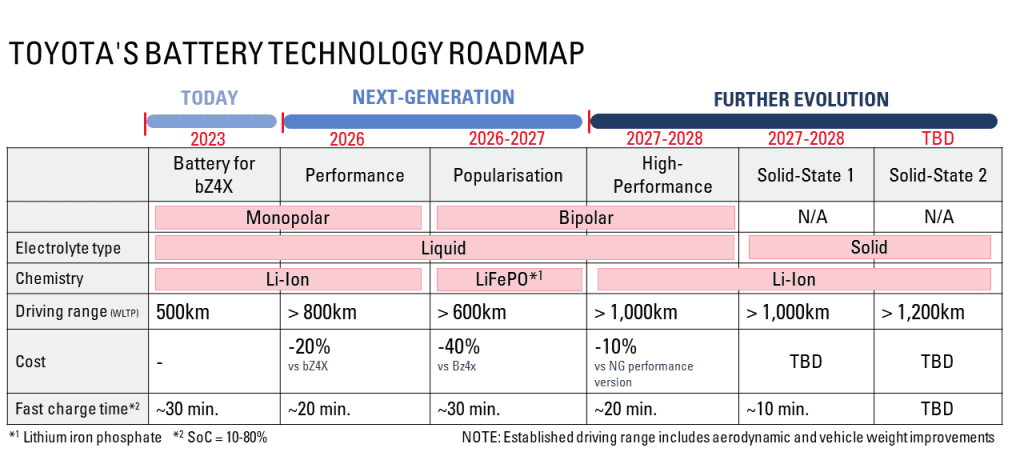
Toyota plans to offer advanced specification BEVs that are loved as driving machines.
Not only will they be designed and built differently, they will also be powered by a range of new advanced batteries developed specifically to exceed Toyota customers’ diverse needs and expectations.
During a recent technical workshop under the theme of “Let’s Change the Future of Cars”, Toyota communicated a first insight into its next-generation BEV breakthrough technologies, including a preview of its advanced battery technology rollout plan.
Takero Kato, president of Toyota’s BEV Factory, indicated that the next-generation BEVs will first hit the market in 2026 and that 1.7m of the 3.5m BEVs Toyota expects to sell by 2030 will be these next-generation models. He also highlighted that a range of battery technologies will be key to appealing BEVs to a wider range of customers and their needs.
“We will need various options for batteries, just like we have different variations of engines. It is important to offer battery solutions compatible with a variety of models and customer needs” – Takero Kato, President, BEV Factory.
Toyota has unveiled four next generation batteries including state-of-the-art advances with both liquid and solid electrolytes, and gave a preview of two further steps with solid electrolyte battery technology.
Improved performance from liquid electrolyte batteries
Batteries with liquid electrolytes, which are currently the mainstream technology for BEVs, are being further developed by Toyota to deliver improved energy density, cost competitiveness and charging speeds.
There are three main technologies under development for liquid electrolyte batteries – ‘Performance’, ‘Popularised’ and ‘High Performance’
1. Performance [Lithium-Ion]
Intended to be introduced with the next-generation BEVs to be introduced in 2026, the Performance Li-Ion battery will increase the cruising range of BEVs to over 800km when combined with improved aerodynamics and reduced vehicle weight.
- 20% reduction in cost (compared to current bZ4X BEV)
- Rapid recharging time of 20 minutes or less (SOC*1 = 10-80%)
- Timing: expected 2026
*1 SOC – State of Charge
2. Popularization [Lithium Iron Phosphate]
Toyota is developing high-quality, lower-cost batteries to support the wider appeal of BEVs by providing customers with a variety of battery options – similar to the choice they have today with different powertrains.
The Popularisation battery is constructed using the bipolar technology that Toyota pioneered and confirmed with its NiMh hybrid electric vehicle batteries, combined with inexpensive lithium iron phosphate (LiFePO) as the core material.
The Popularization battery is expected to offer:
- 20% increase in cruising range (compared to current bZ4X)
- 40% reduction in cost (compared to current bZ4X)
- Fast recharging time of 30 minutes or less (SOC*1= 10-80%)
- Timing: expected 2026-27
3. High-Performance [Lithium-Ion]
Toyota is also developing a High-Performance battery that combines the bipolar structure with Li-Ion chemistry and a high nickel cathode to achieve further advances and further increase cruising range capability to over 1000km when combined with improved aerodynamics and reduced vehicle weight.
The High-Performance battery is also expected to offer:
- Further 10% reduction in cost compared to the Performance battery
- Rapid charging time of 20 minutes or less (SOC*1 = 10-80%)
- Timing: expected 2027-28
Breakthrough with Solid-State Batteries [Lithium-Ion]
Long seen as a potential game-changer for BEVs, Toyota has made a technological breakthrough in its quest to improve the durability of Li-Ion solid-state batteries.
Toyota solid-state batteries have a solid electrolyte, allowing for faster movement of ions and a greater tolerance of high voltages and temperatures.
These qualities make solid-state batteries suitable for rapid charging & discharging and delivering more power in a smaller form.
The trade-off, until now, has been an expected shorter battery life. However, recent technological advancements by Toyota have overcome this challenge and the company has switched its focus to putting solid-state batteries into mass production.
The aim is to be ready for commercial use by 2027-28.
And, while solid-state was initially slated for introduction on HEVs, Toyota’s focus is now primarily on next-generation BEVs.
Toyota’s first solid-state battery is expected to offer:
- 20% increase in cruising range vs. the Performance battery (approx. 1000 km)
- Fast charge time of 10 minutes or less (SOC*1 = 10-80%)
Toyota already has a higher specification Li-Ion solid-state battery under development which is targeting a 50% improvement in cruising range compared to the Performance battery.
Aerodynamics play a key role in determining the range of all vehicles.
Naturally, in the quest to maximize the range of BEVs there is an increasing focus on reducing or optimising Cd (drag coefficient) ratings.
Toyota’s consideration goes one step beyond by focusing on CdA (Cd multiplied by A, frontal area) which, because of the multiplication effect of frontal area, has a much bigger bearing on a vehicle’s range capability.
Central to Toyota’s thinking is the height of the battery, which is typically packaged under the vehicle’s floor. This can lead to an overall increase in vehicle height, which then has a disproportionate multiplied effect on CdA and consequently on vehicle range performance.
If the height of the battery can be reduced then it follows that the overall height of the vehicle can be reduced, CdA can be improved and overall range can be increased.
Therefore, Toyota is also developing ever-flatter battery technology.
Today the battery pack of the bZ4X, including casing, is around 150mm high. Tomorrow, Toyota plans to reduce the battery height to 120mm, and even 100mm in the case of high-performance sports vehicles where a low hip-position is also desirable.
These battery height advancements can have positive impacts on range, driving engagement and packaging depending on how they are deployed in the vehicle.